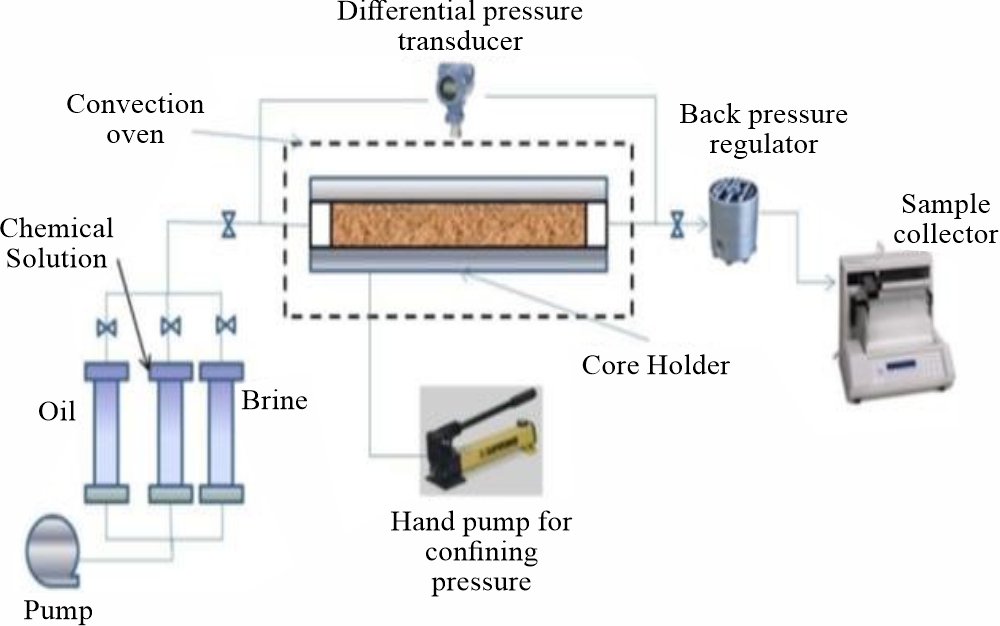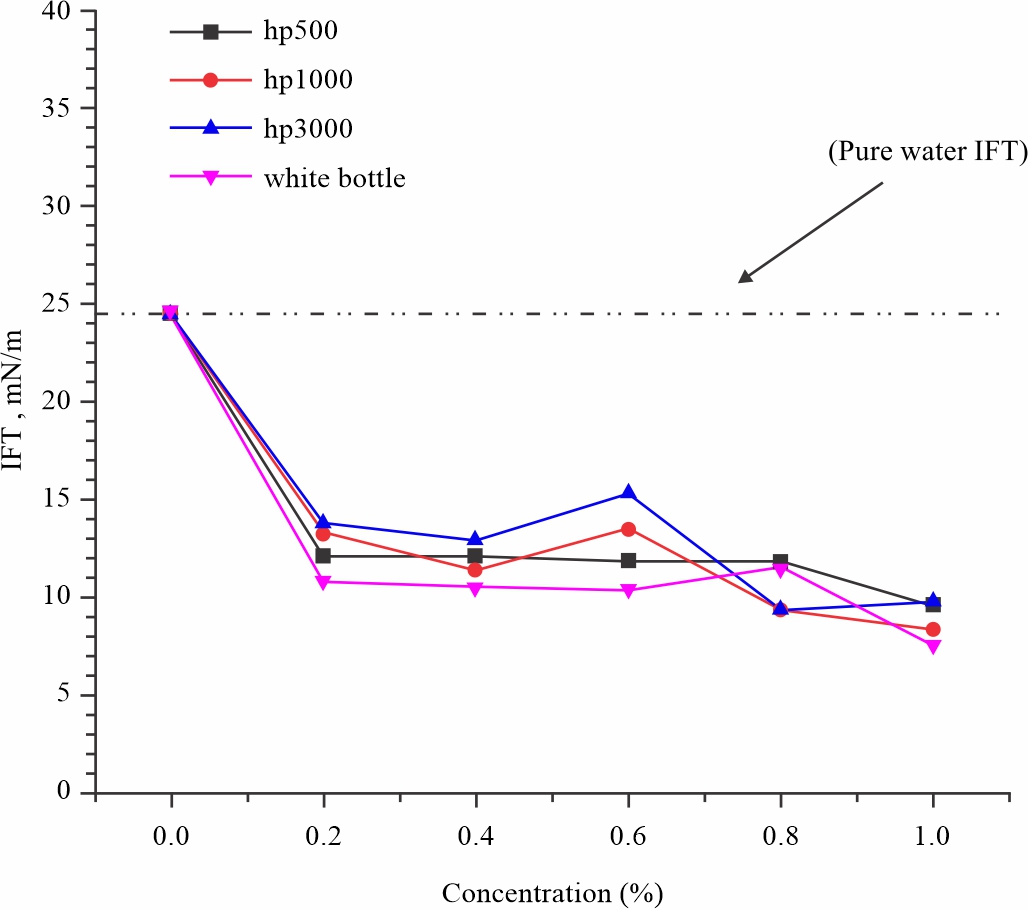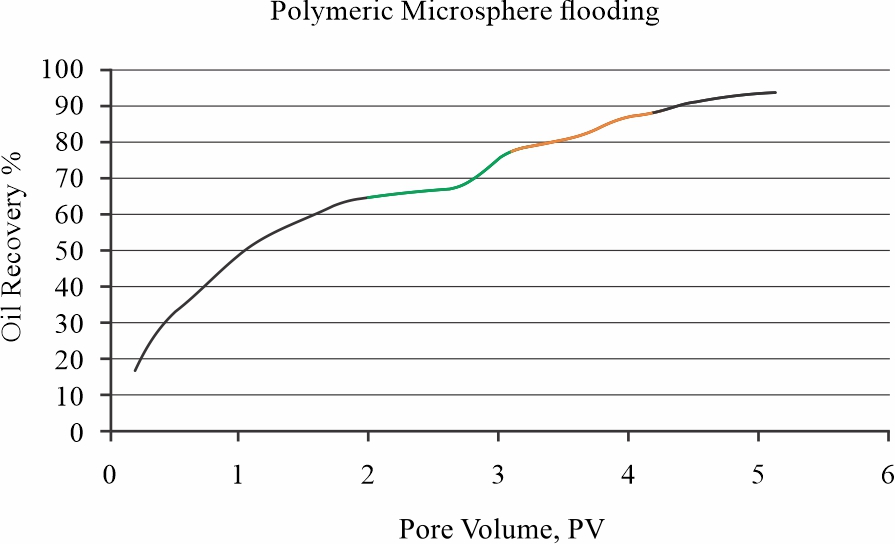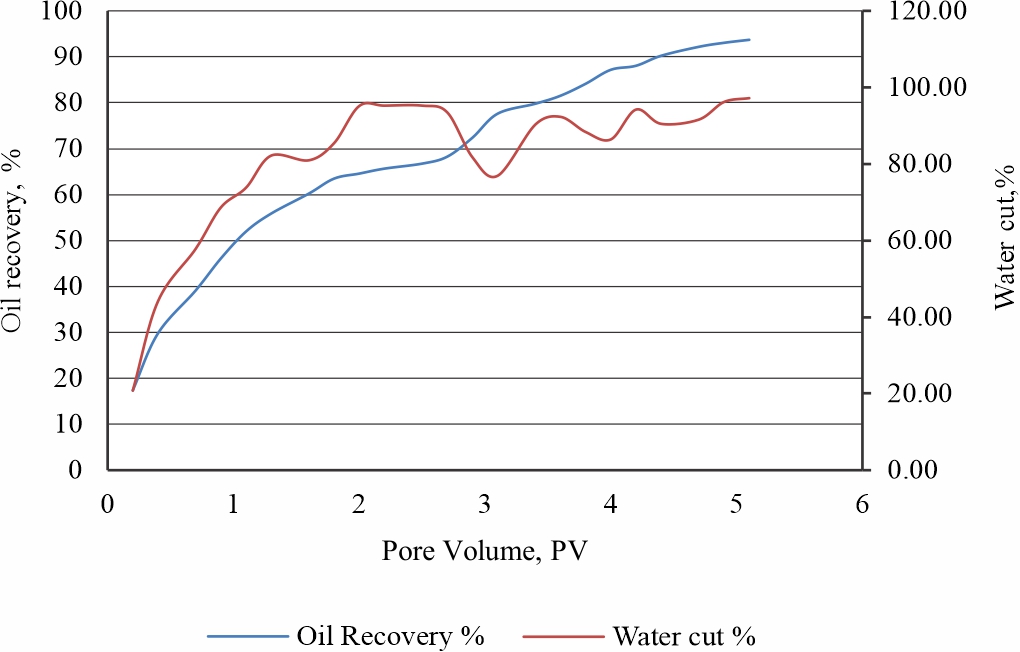Polymeric Microspheres and Guar Gum Study as Chemical Additives to Recover the Residual Oil from the Reservoir
| Received 26 Feb, 2021 |
Accepted 19 May, 2021 |
Published 03 Jun, 2021 |
Background and Objective: For Enhanced oil recovery is a technique that has been used to recover the remaining oil in reservoirs after primary and secondary recovery methods. In this experimental study two different types of chemical injections Polymeric microspheres and Guar hydroxypropyltrimonium chloride were accounted for the injection schemes and their results were compared to select the optimum injection additive and scheme to increase enhanced oil recovery. Materials and Methods: Interfacial Tension (IFT) tests were conducted for Polymeric microspheres and viscosity tests were conducted for Guar gum. Results: Polymeric microspheres reduced sufficiently IFT and mobilized the residual oil from pore throats whereas; Guar gum has high viscosity but did not enhance oil recovery as remarkably as Polymeric microspheres. Conclusion: The experimental observations emphasized that using appropriate chemical additives can improve the chemical flooding for crude oil recovery
INTRODUCTION
In oil fields, the enhanced oil recovery (EOR) techniques are applied to improve the macroscopic and microscopic sweep efficiency to increase the oil recovery1. In other words, these techniques reduce the mobility ratio and tendency of fingering and also affect the porous media properties2. Likewise, it is also versatile to decide the injection criteria to enhance the oil recovery as various Enhanced Oil Recovery (EOR) techniques has been introduced overtime. It was found that polymers tend to increase the viscosity of the injected fluid, in turn; it improves the mobility ratio and reduces the permeability of the water phase3,4. Nevertheless, with the technological development, various researches have been reported on the wettability alteration of porous media by the use of chemical flooding5.
Guar gam systems have rheological and gelation properties, such as elastic property and shear viscosity, these properties are dependent on the constituents of the gel. Indeed, these properties express the gel formation process and can enhance or reduce the performance of the gel in the depth of the reservoir. Rheological and gelation properties of several conventional gel systems, for example, PAtBA/PEI gel, HPAM/phenol-formaldehyde gel and HPAM/chromium (III) Acetate gel, have been reported in many kinds of literature6-8. The formation of wetting conditions is the key factor in improving oil recovery by water flooding through carbonate reservoirs9. The efficiency of the water flooding process can be increased by the addition of chemical agents by altering the rock wettability. Hydrolyzed Poly-Acrylamide (HPAM) can form polyacrylamide based gel systems by crosslinking with organic or metallic cross-linkers to improvise the oil recovery10,11.
In the recent era, nanotechnology has gained enormous interest in the petroleum field and it was found that the use of polymeric microsphere with polymers improved the remarkable oil recovery12-13. Notably, the use of polymeric microsphere in fluids can affect certain properties such as wettability alteration of rocks, reducing the interfacial tension, increasing the mobility of the capillary-traped oil, strengthening sand consolidation and advanced drag reduction. Enhanced oil recovery (EOR) is utilizing polymeric microspheres a new immerging technique for the last few decades. The polymeric microsphere has attracted the great attention of researchers in the field of enhanced oil recovery in the last few decades14. The main aim and objective of this study was to maximize the recovery of crude oil by injecting distinctive additives in reservoirs.
MATERIALS AND METHODS
Study area: This study was carried out at laboratory of China University of Petroleum from July, 2020 to December 2020 in the area of Enhanced oil recovery.
Research protocol: A systemic diagram of the experimental system used in this study is shown in Fig. 1. The details of experimental steps are given below:
Step-1 and 2
| • | Weight the empty sand pack model and then write the weight of the empty sand pack (M1). |
| • | Weight the sand pack plate with sand together and record the weight (M2). |
| • | Pack the sand (sand grains around 60….80 mesh or 80….100 mesh). |
| • | Weight the remaining sand in the plate and record the weight (M3). |
| • | Calculate the weight of sand (M4 = M2-M3). |
| • | Insert the model in the machine, keep the channel the same, open on the model when the temperature reaches 65 C record the initial pressure. |
| • | Begin the saturation of water and correct the fluid rate is 2 ml/min and keeps the pressure normal. |
| • | When water saturation reaches 300 ml in the outlet test tube, record the saturation pressure and take out the model and weigh it and record the weight (M5). |
| • | Then calculate the water weight Mw = M5-M4-M1. |
| • | Calculate the volume of water (V) = Mw/ñ . |
Step-3
| • | Saturation of oil, record the water comes out until the first drop of oil fall. The same procedure of the beginning such as keep the channel the same, the flow rate must be 2 ml/min, the temperature reaches 65 C and turn on the model until the first drop of oil fall in the outlet test tube then stop the experiment and record the water volume, the water volume here will be equal to the initial oil volume. |
Step-4
| 1st water flooding | |
| • | Open the water chamber to check for water, keep the channel the same turn on the model and flow rate when the temperature reaches 65 C begin recording the pressure with time and this process will take about 7 to 8 hrs and then after finishing it chemical flooding process begins. |
Step-5
| Chemical flooding | |
| • | Follow the same procedure of water flooding. |
| • | Inthe end, follow the second water flooding with a similar procedure for the first water flooding. |
 |
Fig. 1: A systemic diagram of the experimental system |
RESULTS AND DISCUSSION
Interfacial tension test: The interfacial tension for all the microspheres was measured and it was found that all the microspheres had low IFT value as compared to water's IFT value. Among all these interfacial tension values the white microspheres had the best lowest values which were used for sand-pack experiments Fig. 2.
 |
Fig. 2: Interfacial tension Test (IFT) |
Oil recovery performance for Microspheres: The oil recovery for Microspheres in sand pack displacement tests is plotted in Fig. 3. The Microspheres were injected into two different halves and it was observed that in both halves oil recovery continued to increase. During the first water flooding stage, a little increase in injection pressure was observed while during the second water flooding it injection pressure increased a little bit more the reason for this was the trapped particles in the sand-pack causing the rise in injection pressure. The oil recovery of the high permeability sand pack was higher than those of the low permeability sand pack; this was the due difference in permeability ratio. The incremental oil recoveries for Guar Gum injection and microspheres injection are 26.95 and 41.04% respectively, From these results, it is very clear that microspheres injection effectively increased the sweep efficiency as compared to Guar Gum injection by plugging the thief zones of the sand pack and diverted the fluid flow towards un-swept zones to recover more oil. As a whole, it can be seen from Fig. 4, that the oil left behind in the reservoir after Guar Gum injection and microspheres injection is 32.21 and 12.21% respectively. These results indicate that microspheres had increased the sweep efficiency of injected fluid and also diverted the fluid flow towards low permeability zones by plugging the thief zones very effectively and recovered more residual oil in the low permeability zones. The sweep efficiency effect was much improved by microspheres in more heterogeneous reservoirs. This is because of the dual property of microspheres to increase the viscosity of the water phase and diverting the fluid flow towards un-swept low permeability zones.
 |
Fig. 3: Oil recover% Vs Pore volume, PV |
Performance of Polymeric Microspheres and Guar Gum: The experimental results at approximately similar conditions for Guar Gum flooding microspheres and flooding are expressed in Fig. 4. During total 3.2 injected pore volume (PV) of fluid injection, which is a clear indication that water mobility is effectively reduced by microspheres injection and may extend the duration of water flooding. It was also observed that, as slug injection starts in both cases water cut starts to decrease, in the case of microspheres slug, water cut fell very sharply but in the same way it increases within no time, while on the other hand in the case of Guar Gum slug injection, water cut starts to decrease gradually and it increases also slowly. Due to this reason the water flooding was enhanced by the injection of microspheres injection which in turn enhances oil recovery (Fig. 5).
 |
Fig. 4: Oil recovery performance of Polymeric Microspheres and Guar Gum |
 |
Fig. 5: Water cut versus oil recovery |
Comparison: The Xanthan gum with Cr3+ system has been extensively applied in the plugging process due to its cost and efficiency. The performance is highly affected by swelling and syneresis phenomenon. The former means the Xanthan can significantly increase its volume by absorbing water, and the latter describes the phenomenon that the swelled gel decreases its volume due to aging or continued cross linking, resulting in a higher crosslink level and stiffness of the gel. On the other hand Microspheres injection has produced much better results than Guar gum injection (Fig. 4). The previous literature reported results on Guar gum which is not as effective as polymeric microspheres do. So in our findings it was found that the microspheres injection is the best choice for injection in the low permeability reservoirs to produce more oil.
CONCLUSION
During gel injection, it was observed that injection pressure for Microspheres was much higher than the injection pressure for guargum. During second water flooding, most of the microsphere particles were flushed out through the outlet due to which injection pressure for microspheres dropped during second water flooding. But during second water flooding injection pressure was still much higher for microspheres flooding than the injection pressure for guar gum injection, which indicates that during second water flooding microspheres were not completely flushed out through the outlet, while few particles were trapped into pore throats and did not propagate so fast and these particles did a good job to plug the thief zones and diverted the water flow towards low permeability zones and increased the sweep efficiency, as a result, enhanced oil recovery is improved as compared to guar gum flooding. Moreover, microspheres reduced the water cut % very effectively as compared to guar gum flooding.
SIGNIFICANCE STATEMENT
This study discovered the new additive i.e. Guar gum and polymeric microspheres that can be beneficial for enhanced oil recovery. Also, this study will help the researchers to uncover the critical areas of optimum injection additive and scheme to increase enhanced oil recovery that many researchers were not able to explore.
REFERENCES
- Sheng, J.J., 2014. Critical review of low-salinity water flooding. J. Pet. Sci. Eng., 120: 216-224.
- Chierici, G.L., 2013. Principles of petroleum reservoir engineering. 1st Edn., Springer Berlin Heidelberg, Germany.
- S.A.A. Ramazani, M. Nourani, M.A. Emadi and N.J. Esfad, 2010. Analytical and experimental study to predict the residual resistance factor on polymer flooding process in fractured medium. Transport Porous Media, 85: 825-840.
- Shi, L., Z. Ye, Z. Zhang, C. Zhou, S. Zhu and Z. Guo, 2010. Necessity and feasibility of improving the residual resistance factor of polymer flooding in heavy oil reservoirs. Pet. Sci., 7: 251-256.
- Strand, S., D.C. Standnes and T. Austad, 2003. Spontaneous imbibition of aqueous surfactant solutions into neutral to oil-wet carbonate cores:? effects of brine salinity and composition. Energy Fuels, 17: 1133-1144.
- Seright, R.S., 2003. An alternative view of filter-cake formation in fractures inspired by Cr(iii)-acetate-HPAM gel extrusion. SPE Prod. Facil., 18: 65-72.
- Reddy, B.R., L. Eoff, E.D. Dalrymple, K. Black, D. Brown and M. Rietjens, 2003. A natural polymer-based cross-linker system for conformance gel systems. SPE J., 8: 99-106.
- Bai, Y., X. Shang, Z. Wang and X. Zhao, 2018. Experimental study of low molecular weight polymer/nanoparticle dispersed gel for water plugging in fractures. Colloids Surf. A: Physicochem. Eng. Aspects, 551: 95-107.
- Puntervold, T., S. Strand and T. Austad, 2007. Water flooding of carbonate reservoirs: effects of a model base and natural crude oil bases on chalk wettability. Energy Fuels, 21: 1606-1616.
- Al-Muntasheri, G.A., H.A. Nasr-El-Din, J. Peters and P.L.J. Zitha, 2006. Investigation of a high temperature organic water shutoff gel: reaction mechanisms. SPE J., 11: 497-504.
- Akbar, I. and Z. Hongtao, 2020. The opportunities and challenges of preformed particle gel in enhanced oil recovery. Recent Innovations Chem. Eng., 13: 290-302.
- Maghzi, A., A. Mohebbi, R. Kharrat and M.H. Ghazanfari, 2010. Pore-scale monitoring of wettability alteration by silica nanoparticles during polymer flooding to heavy oil in a five-spot glass micromodel. Transport Porous Media, 87: 653-664.
- Maghzi, A., R. Kharrat, A. Mohebbi and M.H. Ghazanfari, 2014. The impact of silica nanoparticles on the performance of polymer solution in presence of salts in polymer flooding for heavy oil recovery. Fuel, 123: 123-132.
- Akbar, I., H. Zhou, W. Liu, M.U. Tahir, A. Memon, U. Ansari and F. Lv, 2020. Experimental investigation of chemical flooding using nanoparticles and polymer on displacement of crude oil for enhanced oil recovery. Int. J. Chem. Eng., 2020: 1-10.
How to Cite this paper?
APA-7 Style
Hongtao,
Z., Akbar,
I., Wei,
L., Fengzhang,
L. (2021). Polymeric Microspheres and Guar Gum Study as Chemical Additives to Recover the Residual Oil from the Reservoir. Asian Journal of Emerging Research, 3(1), 40-43. https://doi.org/10.3923/ajerpk.2021.40.43
ACS Style
Hongtao,
Z.; Akbar,
I.; Wei,
L.; Fengzhang,
L. Polymeric Microspheres and Guar Gum Study as Chemical Additives to Recover the Residual Oil from the Reservoir. Asian J. Emerg. Res 2021, 3, 40-43. https://doi.org/10.3923/ajerpk.2021.40.43
AMA Style
Hongtao
Z, Akbar
I, Wei
L, Fengzhang
L. Polymeric Microspheres and Guar Gum Study as Chemical Additives to Recover the Residual Oil from the Reservoir. Asian Journal of Emerging Research. 2021; 3(1): 40-43. https://doi.org/10.3923/ajerpk.2021.40.43
Chicago/Turabian Style
Hongtao, Zhou, Imran Akbar, Liu Wei, and LV Fengzhang.
2021. "Polymeric Microspheres and Guar Gum Study as Chemical Additives to Recover the Residual Oil from the Reservoir" Asian Journal of Emerging Research 3, no. 1: 40-43. https://doi.org/10.3923/ajerpk.2021.40.43

This work is licensed under a Creative Commons Attribution 4.0 International License.




